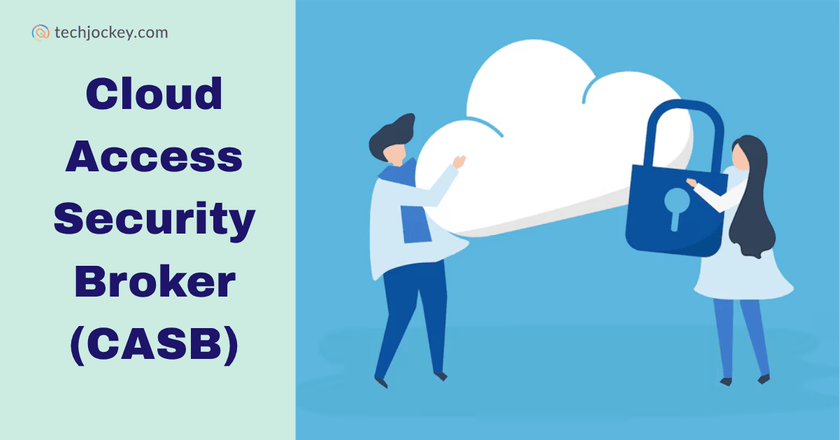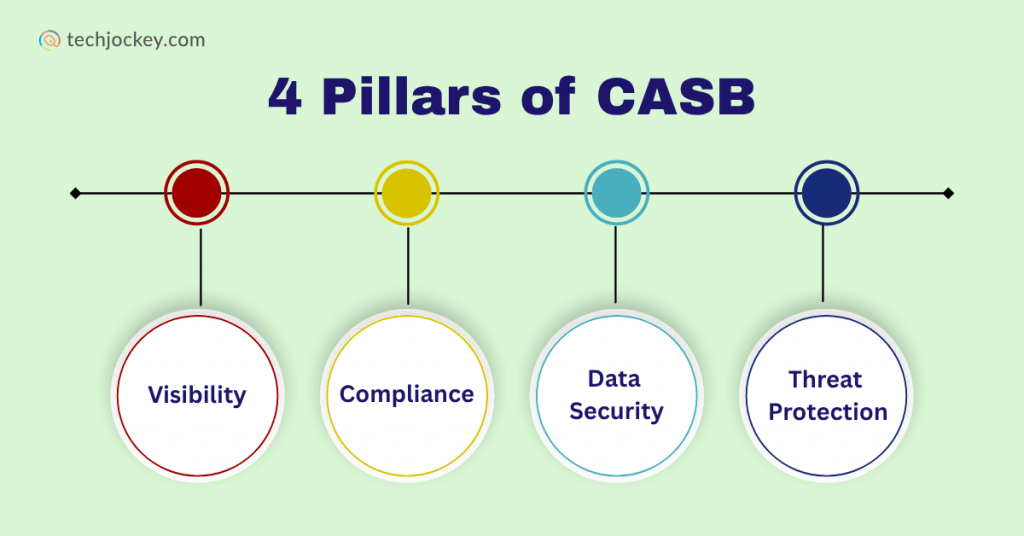What is a Cloud Access Security Broker (CASB): A Complete Guide

Around 45% of organizations have faced at least one cloud-related security issue in the past one year.
Why is this happening?
That’s because businesses are rapidly adopting cloud services, while they remain weak in training their security teams. From unsanctioned app usage to data breaches and compliance violations, cyber threats are rising.
Cloud Access Security Broker is the security shield that helps businesses navigate the cloud-first world safely.
Let’s get into a more detailed explanation of CASB.
What is a CASB?
A Cloud Access Security Broker is a security solution that’s located between cloud service users and cloud service providers.
It monitors and imposes security regulations on all the cloud applications used in an organization, whether approved or shadowed by IT.
CASB offers multi-functionality. It can integrate with many other security technologies, say it authentication, encryption, data loss prevention (DLP), access control, etc, and brings everything in one unified solution.
It can help businesses to use cloud services across SaaS, PaaS, and IaaS platforms without any security fears.
Whether deployed as a cloud-hosted service, an on-premise appliance, or a hybrid setup, CASBs play a critical role in securing the modern cloud ecosystem.
Why Do Businesses Need CASBs?
There’s a lot of business data on the cloud, and a traditional security perimeter can’t be of any help. That’s exactly why CASBs have become essential. Here’s why organizations are turning to them:
The Rise of Shadow IT
Many times, employees use cloud applications without the IT team’s permission. These apps, like Google Drive, Dropbox, or Slack, could be a blind spot for the IT department. The absence of breach visibility sometimes results in the uploading or sharing of sensitive data beyond company policies.
But the presence of CASBs can easily identify these unapproved apps and enforce consistent security policies.
Increasing Compliance Demands
With the growing tech, there’s a need for tight security, too. Thus, many industries have to comply with data protection regulations like HIPAA for healthcare, GDPR for data privacy in the EU, and SOC 2 for service organizations.
If any of the industry fails to comply have to pay hefty fines. CASBs let businesses stay compliant by monitoring how data is stored and shared in the cloud.
Cloud App Sprawl
Businesses now use even more than hundreds of cloud apps, be it CRMs or file sharing tools. These numbers make it hard for the IT team to track usage and secure data movement. CASBs give you a single view across all the platforms in use, thus reducing security risks.
Real-World Risk: Data Leakage
In any case, if an employee uploads confidential client data to any unapproved cloud platform, there is a chance of the data being exposed. This is due to a lack of proper encryption or unrestricted access. CASBs can work well in this situation by detecting and blocking data breaches, resulting in secure boundaries.
Key Functions of a CASB

Cloud Access Security Brokers (CASBs) work through four key pillars. These pillars help businesses stay secure, in control, and compliant across all cloud platforms.
1. Visibility
Cloud Access Security Brokers provides 100% visibility on all the cloud-based apps your employees are using, including sanctioned and unsanctioned both.
They keep track of data and app usage. Not only this, it also keeps in check the risk level of the specific app. This helps teams set smart rules based on users, devices, and behavior.
2. Compliance
Cloud makes it harder to meet rules like HIPAA or GDPR. CASBs help by enforcing policies that match these laws. They watch how data is used and create audit-ready reports. This is key for sectors like healthcare, finance, and legal.
3. Data Security
CASBs keep sensitive data safe while it is being moved or stored. They use tools like DLP, encryption, and access control.
If someone tries to upload client data to a public app, the CASB can block or secure it. This keeps business data within trusted systems, even on personal devices.
4. Threat Protection
CASBs detect threats and block risky activity. They notice things like logins from strange places or sudden data spikes. Tools like sandboxing and URL filters help stop attacks. CASBs also reduce insider threats, whether by mistake or on purpose.
How Does a CASB Work?
CASBs can be deployed in different ways. An organization can choose the model depending on its needs for visibility, control, and performance.
1. Deployment Models
1. API-Based CASB
This model integrates directly with cloud services via APIs. It allows out-of-band monitoring, meaning it doesn’t interfere with traffic flow. API-based CASBs are ideal for retrospective data analysis, compliance auditing, and enforcing security controls without impacting user experience.
2. Proxy-Based CASB
Deployed inline between the user and cloud service, this model inspects traffic in real time. It can block or allow actions instantly based on policy. Proxy CASBs are effective for immediate threat protection and data security, though they may introduce latency if not properly configured.
Some vendors also offer hybrid models that combine API and proxy deployments to offer both real-time control and deep data visibility.
2. Integration with SaaS and Cloud Services
CASBs are also compatible with most well-known cloud environments such as Microsoft 365, Google Workspace, Salesforce, AWS, and others. This enables the organizations to apply uniform policies spread across various cloud environments, irrespective of the service provider.
3. Enforcement Capabilities
CASBs come equipped with robust enforcement tools like:
- Data Loss Prevention (DLP): Prevents exposure of sensitive information
- Encryption & Tokenization: Secures data by masking or replacing it during transmission or storage
- Access Control: Limits data access based on user roles, location, or device
4. Compatibility with Other Security Tools
Modern CASBs are built to operate in conjunction with other tools in the Cybersecurity software stack. They can supply data to Security Information and Event Management (SIEM) systems for centralized monitoring. They can also integrate with Identity and Access Management (IAM) systems to enable central authentication and access control.
In brief, a CASB does not replace the security tools you already use; it supplements them by extending their capabilities into the cloud.
Challenges of Using a CASB
1. Deployment Complexity
It can be technically challenging to implement CASBs, especially the proxy-based ones. There are chances that reverse proxy solutions might not detect unsanctioned applications, and setup often requires fine-tuning for each specific cloud service in use.
2. Integration Limitations
Not all CASBs can integrate with your company’s existing security stack. And partial integrations can still result in blind spots where the broker might not monitor all cloud activity.
3. Scalability Concerns
With your business growing and adopting more cloud services, CASBs must scale accordingly. But not all providers handle large-scale operations well. It can affect the performance of the security operations, leading to possible bottlenecks.
4. Reduced Network Performance
Proxy-based CASBs, while effective in traffic inspection, can introduce latency. This can slow down user access to cloud resources, especially for employees who rely on fast data access for productivity.
5. Cost Implications
Many CASBs operate on a per-user or per-application pricing model. For companies using multiple SaaS tools, costs can escalate quickly, making it an expensive solution, especially for mid-sized organizations.
6. Data Privacy Considerations
CASBs act as intermediaries between users and cloud providers, which raises concerns about where and how sensitive data is handled. Businesses dealing with strict privacy regulations need to thoroughly evaluate how the CASB vendor stores and protects customer data.
Top CASB Tools for Businesses
1. Forcepoint CASB
Forcepoint CASB is a comprehensive cloud management software that offers real-time cloud application discovery, risk scoring, and data classification. It centralizes the enforcement of policies covering DLP, user governance, and device/location-based access from a unified dashboard.
Its pricing starts at ₹23,760 per year at Techjockey.com.

Forcepoint Casb
Starting Price
Price on Request
2. NextGen CASB
Palo Alto Networks’ NextGen CASB delivers advanced scanning and threat prevention, embedding next-gen security features to protect data and maintain compliance in real time. Its pricing is available on request.

Next-Gen CASB
Starting Price
Price on Request
3. Symantec CASB
Symantec CASB provides a unified interface with high-end threat protection and customizable policy enforcement across cloud apps. It emphasizes cloud DLP and risk scoring to help organizations detect and block unauthorized data transfers while maintaining strong compliance controls.

Broadcom Endpoint Protection (Symantec)
Starting Price
Price on Request
Conclusion
Cloud Access Security Brokers (CASBs) help bridge the security gap between cloud services and your internal systems.
They boost visibility, block threats, ensure compliance, and protect sensitive data all from one place.
Yes, there can be setup or integration challenges. But the benefits are much greater.
For companies facing shadow IT, strict compliance, or complex cloud setups, CASBs are a smart investment.
With the right CASB, businesses can innovate in the cloud without losing control or increasing risk.
Mehlika Bathla is a passionate content writer who turns complex tech ideas into simple words. For over 4 years in the tech industry, she has crafted helpful content like technical documentation, user guides, UX content, website content, social media copies, and SEO-driven blogs. She is highly skilled in... Read more




























